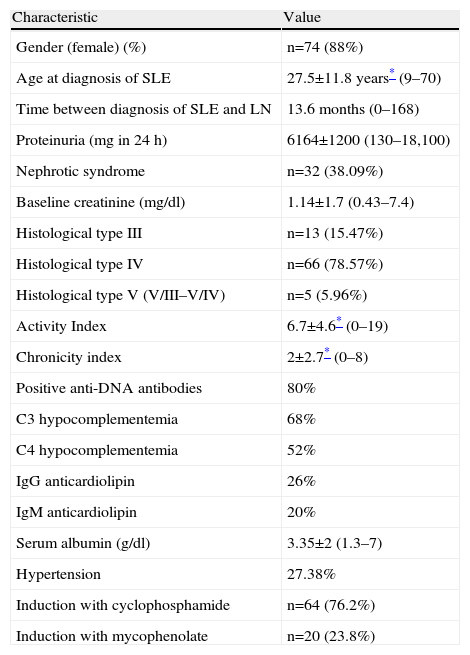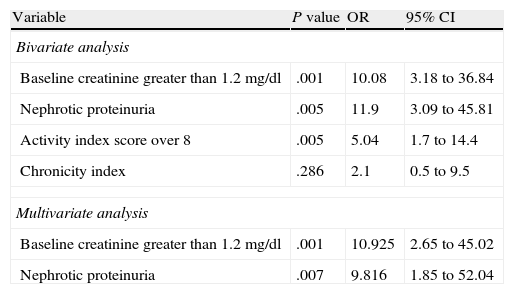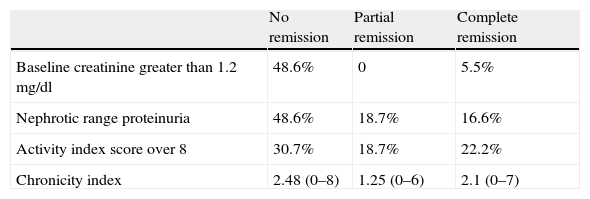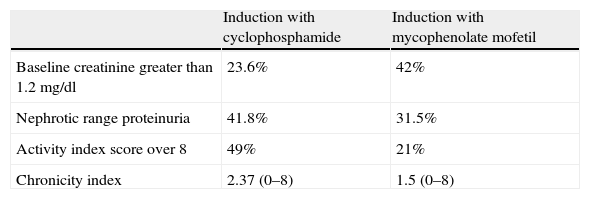To determine the predictors of failure to obtain remission after induction therapy for proliferative lupus nephritis in a group of northwestern Colombian patients.
Material and methodsA retrospective study was conducted. We included patients with systemic lupus erythematosus according to the American College of Rheumatology criteria who had nephritis confirmed by renal biopsy.
ResultsWe followed 84 patients: 88.1% female, and 11.9% male. The mean age at diagnosis of systemic lupus erythematosus was 27.5±11.8 years (9–70). The average time between diagnosis of systemic lupus erythematosus and proliferative nephritis onset was 13.6 months (0–168). Histopathologic type: IV (78.57%), III (15.47%), III–IV/V (5.96%). Activity index: 6.7±4.6. Chronicity index: 2±2.7. 24-hour proteinuria (mg): 6164 (130–18,100). Baseline creatinine: 1.14mg/dL (0.43–7.4). Induction therapy: Steroids (100%), cyclophosphamide (76.2%) and mycophenolate mofetil (23.8%). At six months, 56% of individuals failed to achieve partial or complete remission. Predictors of failure to induction therapy were, in accordance with the bivariate analysis (OR; 95% CI): creatinine level more than 1.2mg/dL (10.8; 3.18–36.84; P<.005), nephrotic range proteinuria (11.9; 3.09–45.8; P<.001), and an activity index above 8 (5.04; 1.7–14.3; P<.001). In the multivariate analysis, only baseline creatinine higher than 1.2mg/dL (10.92; 2.65–45.02; P=.001), and nephrotic range proteinuria (9.81; 1.85–52.04; P=.007) were significant.
ConclusionsA significant percentage of Colombian patients fail to achieve remission of proliferative lupus nephritis after six months of treatment.
Determinar los predictores de falla a la inducción de remisión de la nefritis lúpica proliferativa en pacientes del noroccidente colombiano.
Material y métodosEstudio pragmático con análisis retrospectivo. Se incluyeron sujetos con lupus eritematoso sistémico por criterios del American College of Rheumatology con nefritis confirmada por biopsia renal.
ResultadosSe analizaron 84 pacientes (88,1% mujeres y 11,9% hombres). Edad al diagnóstico del lupus eritematoso sistémico: 27,5±11,8 años (9–70). Tiempo entre el diagnóstico de lupus eritematoso y nefritis proliferativa: 13,6 meses (0–168). Clase histológica: IV (78,57%), III (15,47%), III–IV/V (5,96%). Índice de actividad: 6,7±4,6. Índice de cronicidad: 2±2,7. Proteinuria (mg/24h): 6.164 (130–18.100). Creatinina basal: 1,14mg/dl (0,43–7,4). Terapia de inducción: esteroides (100%), ciclofosfamida (76,2%) y micofenolato mofetil (23,8%). A los 6 meses fallaron en lograr remisión parcial o completa el 56% de los individuos. Los predictores de falla a la terapia de inducción fueron, en el análisis bivariado (OR; IC 95%): creatinina mayor 1,2mg/dl (10,8; 3,18–36,84; p<0,005), proteinuria en rango nefrótico (11,9; 3,09–45,8; p<0,001) e índice de actividad mayor de 8 (5,04; 1,7–14,3; p<0,001). En el análisis multivariado solo fueron significativos creatinina basal mayor de 1,2mg/dl (OR: 10,92; IC 95%: 2,65–45,02; p=0,001) y la proteinuria en rango nefrótico (OR: 9,81; IC 95%: 1,85–52,04; p=0,007).
ConclusionesUn porcentaje significativo de pacientes colombianos con nefritis lúpica proliferativa fallan en lograr remisión a los 6 meses.
Systemic lupus erythematosus (SLE) is a chronic multisystem autoimmune disease with variable clinical features. The frequency of organ involvement and severity vary depending on ethnicity, gender and age of onset.1–5
Lupus nephritis (LN) occurs in 30% of caucasian patients and 60% of African Americans3; in our geographical area, between 50 and 55% of adults.6 7% and 75 children with SLE8 present LN sometime during their disease progression.
In the GLADEL cohort1 (Latin American Lupus Study Group), 51.7% of patients had LN. In this cohort, 58.3% of mestizos lupus patients, 58.3% of African-American and 43.6% of caucasians suffered LN at some point in their evolution.
Between 10 and 25% of SLE patients progress to chronic renal failure (CRF).9,10 Proliferative forms of LN (types III, IV and V associated forms of III or IV) are the most common and serious and can lead to ESRD.11
Baseline levels of creatinine and proteinuria, the presence of hypertension (HT), anti-DNA antibodies, low levels of C3 and C4, high levels of activity and chronicity and Hispanic and African American ethnicity have been identified as poor long-term prognosis factors in patients with proliferative LN.12–21
The current treatment of LN includes an induction of remission phase with high-dose steroids associated with pulse cyclophosphamide (CFM) or mycophenolate mofetil (MMF) and a maintenance phase with low doses of steroids associated with quarterly CFM, MMF or azathioprine (AZA).11
The failure to achieve partial or complete remission at 6 months is associated with poor long-term prognosis and involves greater use of immunosuppressive drugs.11
Few studies have evaluated the impact of early renal response of LN and in the long-term prognosis, baseline creatinine, proteinuria in the nephrotic range, high rates of chronicity and activity, hypocomplementemia and high titers of anti-DNA are poor prognostic factors,10–17 while the normalization of creatinine in the first 4822 weeks and decreased proteinuria in the first 52 weeks are good prognostic markers.23
Normalization of creatinine and proteinuria decreasing to less than 1g in 24h were independent predictors of good long-term prognosis in the24Eurolupus Nephritis Trial.
In Asian patients a longer time to achieve remission and a lack of complete remission are independent predictors of renal relapse, and higher baseline creatinine and failure to achieve complete remission in the first 6 months were independent predictors IRC.25
To our knowledge, no studies have evaluated the predictive factors of failure in inducing remission in LN in a predominantly Hispanic population of Latin American mestizos; in addition, studies that have so far evaluated prognostic factors have ESRD as the primary outcome, not response to induction therapy in the first 6months, hence, the identification of predictors of early therapeutic failure could help select treatments more appropriately in this population with a poor prognosis.
The objective of this study is to define the factors that predict failure of induction therapy in proliferative LN in a cohort of Latin American mestizo patients.
Materials and MethodsWe performed a retrospective consecutive review of a prospective cohort of all patients with 4 or more classification criteria of the American College of Rheumatology (ACR) for SLE, followed at the Pablo Tobon Uribe Hospital, Medellín (Colombia) between January 2004 and December 2010.
The study population consisted of patients diagnosed with proliferative LN26 (histology classes III, IV and V in which glomerulonephritis type III or IV) as classified by the International Society of Nephrology/Renal Pathology Society (ISN/RPS) 2003 coexist; patients received remission induction therapy with CFM 500–1000mg/m2 body surface monthly or MMF 2g via daily orally for 6 months. Children received doses of cyclophosphamide 500mg/m2 of body surface and mycophenolate mofetil 20–40mg/kg/day. All patients received prednisolone 1mg/kg/day for 4 weeks and then underwent gradual dose reduction down to 10mg/day within 4 weeks.
Being a pragmatic clinical practice study, the decision to use CFM or MMF as induction therapy was made by the treating physician.
Primary OutcomesThese were determined at the end of induction therapy based on response criteria for proliferative and membranous renal disease in clinical studies of SLE established by the Ad Hoc Subcommittee of the ACR for27 lupus nephritis.
Complete remission. Defined as glomerular filtration rate (GFR) greater than 90ml/min/1.73m2 of body surface area, less than 500mg/24h proteinuria, inactive urinary sediment (no cell casts and leukocyte and less than 5 erythrocytes and leukocytes per high-power field).27
Partial remission. 25% improvement in GFR, improvement of at least 50% of 24-h proteinuria inactive urinary sediment.27
Baseline impaired renal function. Serum Creatinine at the beginning of induction therapy of 1.2mg/dl or greater.24
Nephrotic range proteinuria. 24h proteinuria greater than or equal to 3500mg/m2 body surface.27
Candidates variables to be risk factors for failure of remission induction were chosen based on the literature. We included: age at diagnosis, sex, creatinine, proteinuria 24h, serum albumin, presence of hypertension, C3 and C4 hypocomplementemia, anti-DNA antibodies, IgG and IgM anticardiolipin antibodies, histological classes LN, activity indices and chronicity of the same classification and the use of CFM or MMF as induction therapy.10–26
Statistical AnalysisFor the descriptive analysis of quantitative variables we employed measures of central tendency and dispersion, with their respective normality tests.
For each case (failure to achieve complete or partial remission at 6 months) a control from the same cohort (achieving partial or complete remission at 6 months) was assigned. To analyze the association between patient age and the age at diagnosis of SLE, with the failure of induction of remission therapy we used the Student's t-test (mean difference) which had normal distribution, and the Mann–Whitney U-test (median difference) for non-normal distribution.
To determine the association between dichotomous qualitative variables (sex, anti-DNA antibodies) and recategorized (creatinine, proteinuria, activity index, chronicity index and failure therapy remission), the Chi square test was used Mantel–Haenzsel.
To analyze the association of demographic variables and qualitative clinical treatment failure variables we employed Pearson's Chi square test.
Other quantitative variables were categorized to establish the association of these variables with the failure in remission therapy, and analysis was performed using the Pearson Chi square test.
To establish the association between each of the variables analyzed and its association with failure of remission therapy for proliferative LN, odds ratio (OR) were calculated with their respective confidence intervals (CI), and a confidence level of 95%.
Having established the factors associated with therapy failure, a logistic regression model was proposed to identify the independent variables for failure in inducing remission. The type of multivariate analysis used was “backward”: all variables were entered into the equation in SPSS and then were excluded one after another, the variables that had the smallest partial correlation with the dependent variable were excluded. The accuracy of the model was assessed with the Hosmer and Lemeshow test.
The project was approved by the Research Ethics Committees of the University and the CES Pablo Tobon Uribe Hospital, Medellín (Colombia).
ResultsThe study population consisted of 84 patients: 74 women (88.1%) and 10 men (11.9%) with a mean age of 27.3±12.4 years (28 for women and 32.5 for men). The average age at diagnosis of SLE was 27.5±11.8 years (9–70) in women was 24.12 years (9–70) and in men, 30.4 years (18–57).
The time elapsed between diagnosis of SLE and the diagnosis of LN was 13.6 months (0–168): 13.72 months in women and 12.8 months in men.
The diagnosis of SLE and LN coincided in 36.9% of cases, 63% of patients had LN in the first 6 months of their disease, 72% in the first year, 14.28% between one and five years, 8.96% between 5 and 10 years and 4.76% after 10 years of diagnosis of SLE. 5 patients under 16 years were included, with a median age of 12.6 years (9–15) in the cohort.
The main clinical characteristics of LN diagnosis are described in Table 1.
Clinical and Demographic Data in 84 Hispanic Patients With Proliferative Lupus Nephritis.
| Characteristic | Value |
| Gender (female) (%) | n=74 (88%) |
| Age at diagnosis of SLE | 27.5±11.8 years* (9–70) |
| Time between diagnosis of SLE and LN | 13.6 months (0–168) |
| Proteinuria (mg in 24h) | 6164±1200 (130–18,100) |
| Nephrotic syndrome | n=32 (38.09%) |
| Baseline creatinine (mg/dl) | 1.14±1.7 (0.43–7.4) |
| Histological type III | n=13 (15.47%) |
| Histological type IV | n=66 (78.57%) |
| Histological type V (V/III–V/IV) | n=5 (5.96%) |
| Activity Index | 6.7±4.6* (0–19) |
| Chronicity index | 2±2.7* (0–8) |
| Positive anti-DNA antibodies | 80% |
| C3 hypocomplementemia | 68% |
| C4 hypocomplementemia | 52% |
| IgG anticardiolipin | 26% |
| IgM anticardiolipin | 20% |
| Serum albumin (g/dl) | 3.35±2 (1.3–7) |
| Hypertension | 27.38% |
| Induction with cyclophosphamide | n=64 (76.2%) |
| Induction with mycophenolate | n=20 (23.8%) |
SLE: systemic lupus erythematosus; LN: lupus nephritis.
54% of individuals had hypoalbuminemia and 75%, hypocomplementemia. The average baseline proteinuria of the population was 6.164mg/24h (130–18,100), 32 patients (38.09%) had nephrotic range proteinuria, the mean baseline creatinine was 1.14mg/dl (0.43–7.4) and 24 patients (28.57%) had impaired renal function at the first evaluation. 78.57% of the subjects had diffuse proliferative LN, the average activity rate was 6.7±4.6 (0–19) and chronicity index, 2±2.7 (0–8).
Thirty-seven patients (44%) achieved partial or complete response at 6 months (23.8% complete response and 20.2% partial response), and 47 subjects (56%) failed to enter remission. 52.7% of women and 80% of men failed to achieve at least partial remission 6 months, 23.4% of individuals (11/47) with failure in inducing remission achieved at least partial remission at 12 months of treatment (6 partial remission and complete remission.
Induction therapy was steroid 1mg/kg in decreasing doses in all patients, CFM in 64 individuals (76.2%) and MMF in 20 subjects (23.8%).
Nephrotic range proteinuria (OR: 11.9, 95% CI from 3.09 to 45.81, P=.005), baseline renal function impairment (OR: 10.8, 95% CI: 3.18 to 36.84, P=.001) and the rate of more than 8 points of activity (OR: 5.04, 95% CI: 1.7 to 14.4, P=.001) were associated with failure to induction therapy.
By multivariate analysis, only baseline impaired renal function (OR: 10.92, 95% CI: 2.65 to 45.02, P=.001) and nephrotic range proteinuria (OR: 9.81, 95% CI: 1.85 to 52.04, P=.007) were independent predictors of failure to remission induction therapy at 6 months (Table 2).
Factors Associated With Failure in the Induction Therapy of Proliferative Lupus Nephritis in 84 Hispanic Patients.
| Variable | P value | OR | 95% CI |
| Bivariate analysis | |||
| Baseline creatinine greater than 1.2mg/dl | .001 | 10.08 | 3.18 to 36.84 |
| Nephrotic proteinuria | .005 | 11.9 | 3.09 to 45.81 |
| Activity index score over 8 | .005 | 5.04 | 1.7 to 14.4 |
| Chronicity index | .286 | 2.1 | 0.5 to 9.5 |
| Multivariate analysis | |||
| Baseline creatinine greater than 1.2mg/dl | .001 | 10.925 | 2.65 to 45.02 |
| Nephrotic proteinuria | .007 | 9.816 | 1.85 to 52.04 |
95% CI: 95% confidence interval; OR: odds ratio.
Using bivariate analysis, systolic blood pressure, age at start of treatment, complement levels and anti-DNA titers showed no significant difference between patients who achieved remission at 6 months and those who did not. The chronicity index was not associated with treatment failure (OR: 2.1, 95% CI from 0.5 to 9.5, P=.286). There was no difference between patients who achieved remission or not in terms of l time elapsed between diagnosis of SLE and the development of LN (Mann–Whitney, P=.456). Gender was not associated with failure to treatment (χ2 test P=.088).
The different histological types were shown not to be predictive of failure of induction of remission at 6 months; taking a s a references LN type iii, the OR for treatment failure was 3.84 (95% CI: 0.9 to 15.7) for LN and type 2 IV (95% CI: 0.2 to 18.3) for LN type V/III or V/IV, no statistically significant association was demonstrated between histological type and treatment failure at 6 months (χ2P=.135). Frequency of factors associated with failure in inducing remission according to clinical response at 6 months are shown in Table 3.
Frequency of Occurrence of the Factors Associated With Failure in Inducing Remission According to Clinical Response at 6 Months.
| No remission | Partial remission | Complete remission | |
| Baseline creatinine greater than 1.2mg/dl | 48.6% | 0 | 5.5% |
| Nephrotic range proteinuria | 48.6% | 18.7% | 16.6% |
| Activity index score over 8 | 30.7% | 18.7% | 22.2% |
| Chronicity index | 2.48 (0–8) | 1.25 (0–6) | 2.1 (0–7) |
No differences in outcome between patients treated with MMF and CFM in the induction phase were observed, 43.75% of patients receiving CFM and 45% of those receiving MMF achieved partial or complete remission at 6 months. Subjects receiving MMF reached complete remission in 20% and partial remission in 25%; those receiving CFM reached 25 and 18.75% of complete and partial remission, respectively.
The frequency of occurrence of the factors associated with failure in inducing remission in patients treated with MMF and CFM shown in Table 4.
Frequency of Occurrence of the Factors Associated With Failure in Inducing Remission in Patients Treated With Cyclophosphamide and Mycophenolate Mofetil.
| Induction with cyclophosphamide | Induction with mycophenolate mofetil | |
| Baseline creatinine greater than 1.2mg/dl | 23.6% | 42% |
| Nephrotic range proteinuria | 41.8% | 31.5% |
| Activity index score over 8 | 49% | 21% |
| Chronicity index | 2.37 (0–8) | 1.5 (0–8) |
The Nagelkerke R square showed that the variables included in the model explain about 50% of the outcome of this study and the goodness of fit test of the Hosmer and Lemeshow test was significant (P=.71) indicating that the model used is adjusted.
DiscussionThe remission of LN in the first 6 months of treatment reduces the need for potentially toxic drugs and has been identified by several authors as a prognostic factor.24,25
Houssiau et al.,24 showed that a decrease in creatinine (OR: 14.9, 95% CI: 2 to 111.8, P=.01) and proteinuria to less than 1g at 6 months (OR: 63, 95% CI: 1.2 to 34.4, P=.03) were independent predictors of good long-term prognosis in Europeans patients with LN. In that study, 22% of patients baseline had impaired renal function and 28% had nephrotic syndrome.
In Asian patients,25 showed the longest latency between diagnosis of LN and the start of treatment (P=.002) and lack of complete remission at 6 months were independent predictors of renal relapses, and most baseline creatinine and remission status at 6 months were independent predictors of ESRD.
In our population of patients with poor prognostic factors, Latin American mestizos, with baseline creatinine greater than 1.2mg/dL in 28.57% of patients with nephrotic proteinuria in 38.09% of cases, achieving early remission is crucial for the long-term prognosis.
Patients with membranous glomerulonephritis in whom glomerulonephritis type III or IV26 coexisted were included, as was done in the Eurolupus study24; in our population, the clinical course, prognosis and response to treatment of patients with this histological class were indistinguishable from that observed in class III and IV without associated membranous nephritis.7 In our population, the association of membranous glomerulonephritis was not a predictor of failure of induction of remission in proliferative forms of LN, as observed by So et al.25 There was no difference in the probability of failure in the induction of remission between the histological types studied.
23.8% of our patients achieved complete remission and 20.2% partial remission at 6 months, which is lower than that observed by So et al.,25 in Asian patients;. These authors saw complete remission in 50% and partial remission in 28.2%. In this cohort of Latin American mestizo patients, poor response to induction treatment of LN can be an indicator of severity and treatment resistance (Table 3).
A quarter of patients who failed to achieve partial or complete remission at the end of the induction phase achieved remission at one year. The probability of achieving remission after induction therapy has been described by several authors. Remission rates of LN at the end of remission induction period in the28 Aspreva study was: 8.6% in the group receiving MMF and 8.1% in those receiving CFM, however, 62.1 and 59.1%, respectively, achieved complete remission during the maintenance phase.29 The authors suggest that the distinction between the induction phase and the maintenance phase may be artificial in LN.
Although the study was not designed to assess the superiority of one scheme of remission induction over another, the probability of achieving partial or complete remission at 6 months of treatment was similar among patients treated with MMF and those treated with CFM (Table 4).
The weaknesses of this study are typical of observational studies and possible bias occurred in patients assign CFM due to more severe disease. However, although patients who received induction with cyclophosphamide had higher activity and chronicity indices and higher percentage of nephrotic range proteinuria, patients receiving mycophenolate had impaired baseline renal function more often.
The strengths of the study are: the number of patients included, the strict selection criteria and response to treatment, the analysis of all published predictors of LN and evaluation of Latin American mestizo patients.
A high chronicity score is associated with lower rates of remission and chronic renal failure relapses more often in patients with LN.10–21 In our cohort, the chronicity index was not associated with a lower rate of remission at 6 months, probably because the biopsies were performed early in the evolution of the LN and chronicity indices were low (2±2.70* [0–8]).
In conclusion, in a Latin American mestizo population with LN, 23.8% of patients achieve complete remission and 20.2% partial remission at 6 months no difference between those receiving MMF and CFM was seen. Nephrotic range proteinuria and creatinine of 1.2mg/dl at diagnosis were independent predictors of failure to achieve remission at 6 months.
Ethical ResponsibilitiesProtection of people and animalsThe authors declare that no experiments have been performed on humans or animals.
Data confidentialityThe authors declare that they have followed the protocols of their workplace regarding the publication of data from patients and that all patients included in the study have received sufficient information and have given their written informed consent to participate in the study.
Right to privacy and informed consentThe authors have obtained informed consent from all patients and/or subjects referred to in this article. This document is in the possession of the corresponding author.
Conflict of InterestThe authors declare that no financial relationship exists that could give rise to a conflict of interest relating to this article.
Research Unit, Hospital Pablo Tobon Uribe, Medellín, Colombia.
Please cite this article as: Pinto Peñaranda LF, Castro Mercado IL, Duque Caballero V, Márquez Hernández JD, Velásquez Franco CJ. Factores de riesgo predictores de falla a la terapia de inducción de nefritis lúpica en una cohorte de pacientes colombianos. Reumatol Clin. 2014;10:147–151.










